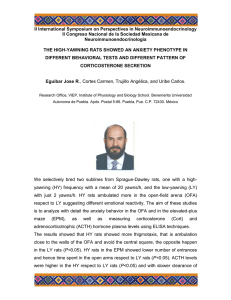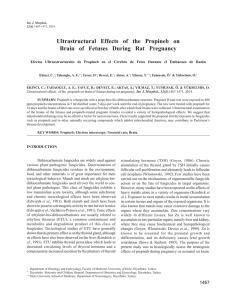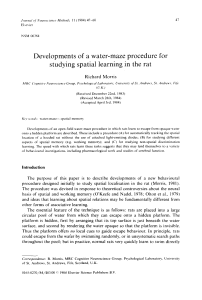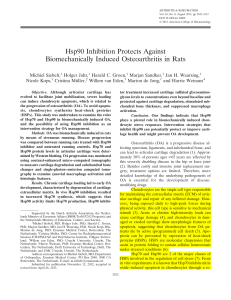four day cognitive behavioral treatment of a rat phobic
Anuncio
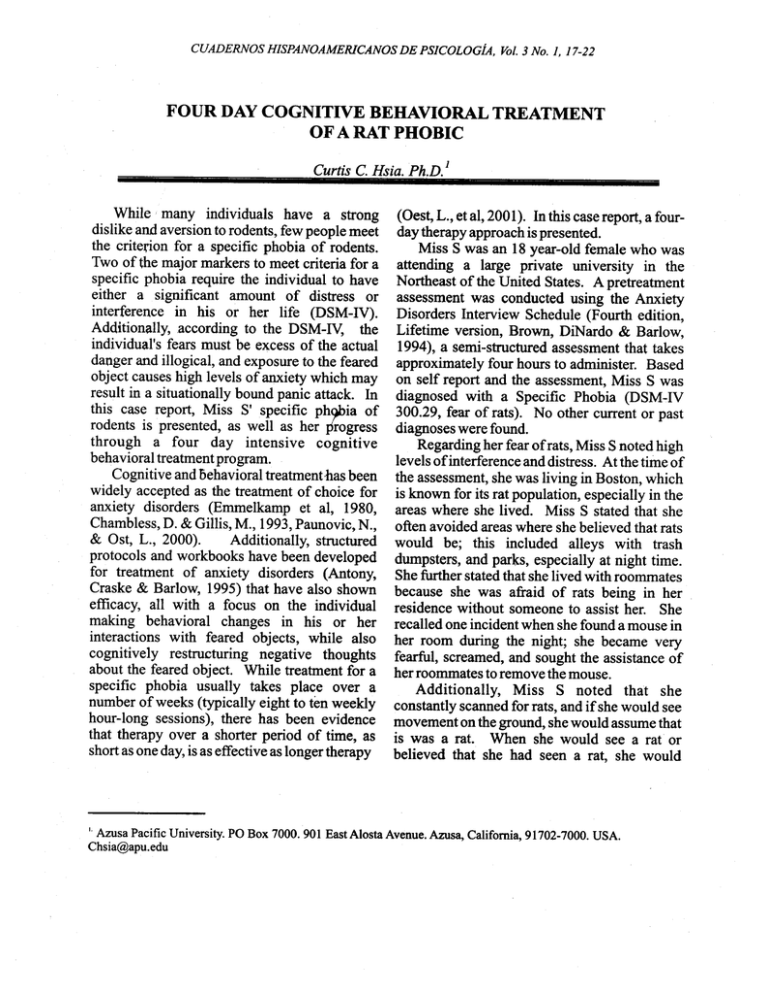
FOUR DAY COGNITIVE BEHAVIORAL TREATMENT OF A RAT PHOBIC Curtis C. Hsia. Ph.D. While many individuals have a strong dislike and aversion to rodents, few people meet the criterion for a specific phobia of rodents. Two of the major markers to meet criteria for a specific phobia require the individual to have either a significant amount of distress or interference in his or her life (DSM-IV). Additionally, according to the DSM-I~ the individual's fears must be excess of the actual danger and illogical, and exposure to the feared object causes high levels of anxiety which may result in a situationally bound panic attack. In this case report, Miss S' specific ph<)bia of rodents is presented, as well as her progress through a four day intensive cognitive behavioral treatment program. Cognitive and behavioral treatment-hasbeen widely accepted as the treatment of choice for anxiety disorders (Emmelkamp et aI, 1980, Chambless, D. & Gillis, M., 1993,Paunovic, N., & Ost, L., 2000). Additionally, structured protocols and workbooks have been developed for treatment of anxiety disorders (Antony, Craske & Barlow, 1995) that have also shown efficacy, all with a focus on the individual making behavioral changes in his or her interactions with feared objects, while also cognitively restructuring negative thoughts about the feared object. While treatment for a specific phobia usually takes place over a number of weeks (typically eight to t€mweekly hour-long sessions), there has been evidence that therapy over a shorter period of time, as short as one day, is as effective as longer therapy 1 (Oest, L., etal, 2001). In this case report, a fourday therapy approach is presented. Miss S was an 18 year-old female who was attending a large private university in the Northeast of the United States. A pretreatment assessment was conducted using the Anxiety Disorders Interview Schedule (Fourth edition, Lifetime version, Brown, DiNardo & Barlow, 1994), a semi-structured assessment that takes approximately four hours to administer. Based on self report and the assessment, Miss S was diagnosed with a Specific Phobia (DSM..,IV 300.29, fear of rats). No other current or past diagnoses were found. Regarding her fear of rats, Miss S noted high levels of interference and distress. At the time of the assessment, she was living in Boston, which is known for its rat population, especially in the areas where she lived. Miss S stated that she often avoided areas where she believed that rats would be; this included alleys with trash dumpsters, and parks, especially at night time. She further stated that she lived with roommates because she was afraid of rats being in her residence without someone to assist her. She recalled one incident when she found a mouse in her room during the night; she became very fearful, screamed, and sought the assistance of her roommates to remove the mouse. Additionally, Miss S noted that she constantly scanned for rats, and if she would see movement on the ground, she would assume that is was a rat. When she would see a rat or believed that she had seen a rat, she would I. Azusa Pacific University. PO Box 7000. 901 East Alosta Avenue. Azusa, California, 91702-7000. USA. Chsia@apu.edu become highly distressed, experience a situationally bound panic attack, try to leave the situation by exiting the area, or if that were not possible, she would try to get to a safe area where the rat could not reach her, such as a chair or other high place. If Miss S saw a rat on the television, she would turn the channel quickly. She refused to look at pictures of rats. If people around her discussed rats, she would also become very fearful and would ask them to refrain from talking about rats. She also stated that she had nightmares of rats and would wake up screammg. Based on her presentation (specifically, lack of other diagnoses that would interfere with therapy), it was decided to use an intensive four day cognitive behavioral treatment protocol. On days one and two, each session lasted approximately two hours with the therapist. Additionally, the homework assigned (a combination of readings, answering questions about the reading and her own fears, and exposure practices) averaged approximately two to three hours per night. Day three included approximately two hours of in-session therapy, and two hours of exposure, with homework assigned. Day five included over two hours of exposure. The treatment protocol was based on an established eight session cognitive behavioral protocol with an emphasis on exposure therapy. Miss S came to the Center for Anxiety and Related Disorders at Boston University. She was formally introduced to the psychologist who would be working with her. After answering questions from the patient (questions included specific inquiries about the therapy, the therapist's background, and what she would be expected to do during therapy), a review of her current symptoms was conducted; it was found that during the interim between the assessment and the first session she had an increase in anxiety about rats. To better assess her current level of functioning, several stimuli were introduced, always with Miss S' approval before they were shown. She exhibited high levels of anxiety when shown pictures of rats from a book, and moderate levels of anxiety when shown a toy rubber rat (Miss S noted that since she knew that the rat was not real before it was presented, she was not too fearful of it; still, was not relaxed when the rubber rat was shown, and she did not like looking at the tail). An overview of therapy was then conducted, noting that the first day was primarily psychoeducation. This entailed an interactive discussion about what a phobia is, and how her fears were being maintained. Several key concepts were introduced on the first day; this included the Subjective Units of Distress Scale (SUDS), the three-component theory, and information about the fight-or-flight system. The three component system is used to describe the interaction between cognitions, behaviors, and physiological response. Each of the three components (cognitions, behaviors and physiological response) are described as building on each other to increase one's fears and avoidance. For example, if an individual sees a rat, she may think "A rat! How horrible! It may bite me!" With such thoughts, the fight or flight system initiates, which increases physiological arousal, which can cause a situationally bound panic attack. Additionally, because of the cognitions and physical response, she may leave the area to get away from the rat. The three component system is used as the basis for the description of how a fear is maintained, and the patient is told that each area of the three component system will be addressed in therapy, which will lead to the extinction ofthe fear. The Subjective Units of Distress Scale, or SUDS, is used to help both the therapist and patient quantify the level of anxiety being experienced by the patient. As each individual may have varying levels of anxiety to the same stimuli, the SUDS is very useful to keep track of a patient's progress throughout treatment. Typically the SUDS ranges between zero and 100; however any set of numbers is acceptable. A SUDS level of zero is considered to be completely calm and relaxed. A SUDS of 40 is considered moderate, and usually an individual with a phobia would try to leave the situation if the level were this high. A SUDS of 100 indicates the highest possible level of anxiety, denoting a worst case scenario (e.g., have several live rats on her person). At the end of the first day, Miss S was assigned homework to complete before she returned the next day. Homework included reading assignments out of a workbook which corresponded to the material covered during the session; in addition, she was asked to take both the toy rubber rat and the book of rat photographs home with her. She was not directed to look at the pictures; rather she was asked just to carry them with her. Miss S stated that she would be able to complete the homework and noted a SUDS of30 for carrying the items in her purse. The second day of treatment began with a review of her homework, which she completed without any problems. She also stated that she now had no fear of carrying the book of rat photos with her, and did not have any concerns about having the rubber rat in her purse; in fact, she and her friends made it a necklace and had given it a name. During day two, cognitive challenging was introduced. Specifically during day two, the concept of "probability overestimation" was defined, described, and practiced. Probability overestimation is defined as overestimating the likelihood of a feared event occurring. One component of phobias is the irrational fear of an event occurring; oftentimes the patient has not critically examining the likelihood of said event actually happening. During this phase of treatment, the patient is asked to describe a feared situation; Miss S immediately described a scenario of a rat running over her foot, and another of a rat biting her. Miss S was then asked to critically examine the first scenario (rat running over her foot). She was first asked how often a rat had actually run over her foot (never). She was then asked how many times this had happened to one of her friends; she immediately noted that it had happened to an acquaintance. The psychologist pointed out that this was "good" in that it reinforced a key concept in probability overestimation; an accurate likelihood of events occurring. It was noted that this happened to just one of her friends once in her lifetime, and was a rare occurrence. She agreed that the likelihood that a rat would run over her foot would be highly unlikely. This was furthered after an explanation of rat behavior; rats would not run towards a large animal, as this would likely cause its death (fight or flight system for the rat), and would more likely run away. Additionally, Miss S was asked why she did not fear other events that would be more likely and catastrophic (e.g., being run over by a car). She immediately understood the nature of the phobia and lack oflogic of her reasoning. After a short break, Miss S was asked to look at pictures in the book she had been carrying. She immediately showed high levels of anxiety, but agreed to look at the pictures. A picture was chosen with SUDS ratings of 50; she was asked to stare at the picture, which she was able to do. After 5 minutes, her SUDS was down to 20. Four pictures with SUDS ratings of 50 to 80 were selected for her to look at that evening as part of her homework. Additionally, Miss S was assigned to practice at home critically examining probability overestimation in other situations that she feared about rats (e.g., being bitten by a rat), and continue her readings that reinforced what she had learned on day two. Day three began with a review of her homework; she was able to accurately estimate the likelihood of some of her feared events occurring. She had some questions about the readings, which were discussed. Miss S was now able to look at any of the pictures in the rat book with minimal levels of anxiety; she even found some ofthe pictures "cute." Treatment continued with an introduction to "catastrophization," or the concept of assuming that any interaction with the feared object (in this case rats) would result in horrible consequences (death, or a fate worse than death). During this portion of the cognitive treatment, the focus was examining what the negative cognitions were, and to critically examine without bias how bad the consequences really were. Miss S' worse case scenarios included having a rat run over her foot, holding a 'rat, and"'eing bitten by a rat. While none of these outcomes are generally seen as positive by most people, Miss S so highly feared these situations that she had avoided many things in life so that they would not occur without fully examining her fears. The following is an example of the patient/therapist interaction in discussing catastrophization: Therapist: You mentioned that one of your fears is having a rat run over your foot. What is so bad about that? Miss S.: (immediately frowns and shows some anxiety) It would be disgusting and creep me out. Therapist: Ok, what exactly makes it disgusting and creepy? Miss S.: Well, the feeling of its feet on my skin. That gives me the shivers. Therapist: Have you ever experienced anything really horrible in your life? Something that you thought would just overwhelm you, but you managed to cope with it? Miss S.: Well, yes, I can think of a few times in my life that I've managed to deal with things that were pretty hard. It took some time to get over, but I did. Therapist: How long do you think a rat would take to run over your foot? Therapist: Probably. Do could handle a few discomfort, in comparison other things you've overcome in your life? you think you seconds of to some,ofthe managed to Miss S.: I suppose. But I defHlitely wouldn't like it, and wouldn't want to do it if! had a choice. Therapist: Good! So you know you can do it now the question becollles, is it worth it? Is it worth it to be around a rat to overcome your fears of them, SO you can do things that you want to? That is something only you can answer. Miss S.: But I'll probably scream if! see it, and I may embarrass myself1 And I'm scared. Therapist: That's all perfectly normal we expect that. Keep in mind rats are things you've avoided for years. But have you ever been embarrassed before? Therapist: Are you still embarrassed about them? My guess is that currently you still aren't embarrassed about things that happened years ago; in fact you may now find them funny. Therapist: So you've coped with embarrassing situations· before; perhaps not as well as you'd like, but you you've survived. This is no different. All you need to think about is, is the payoff worth the cost? Are you willing to be embarrassed, deal with high levels of anxiety for a little while to get over your fears? As noted, the focus of the cognitive therapy over the two days is for the patient to recognize that the likelihood of her feared events are very low, and in most cases, even if they do occur, they are not as bad as she initially imagines. In the next segment of therapy, Miss S agreed to watch films of rats. This included several different movie clips and a documentary on rats, all of which included extended visual images of rats in various settings, including in public areas, inside houses, and on people. After initial high anxiety, Miss S was able to watch the films with low SUDS. This process took approximately two hours. By the end of the two hours, the only portion of the film which she found anxiety provoking was a scene of a man on his back with several hundred rats on and around him For homework, Miss S was assigned to watch the segment of the film which she found anxiety provoking for one hour. Additionally, she was to read provided information on catastrophizing and desensitization. Finally, she was asked to write down why she wanted to overcome her fears of rats, as she knew that on the following day she would be asked to face her fears of rats by actually handling them. While she was anxious, she stated that she felt ready for the next day's treatment. A review of Miss S' homework indicated that she thoroughly understood the cognitive aspects of the therapy, and understood that her fears were illogical. Further she realized that her concerns were unlikely to occur, and even ifthey did, they were not as bad as she initially believed. She also had very little anxiety to pictures of rats, thoughts of rats, or videos of rats. While she was highly anxious to actually be near live rats, she knew from her previous exposure to other stimuli (pictures, videos) that after initial anxiety she would most likely become less anxious and more comfortable around them. She also recognized that need to face her fears if she wanted to no longer be fearful of rats and live her life in a way that she wanted to. Based on her own self-assessment and the therapist's, it was agreed that Miss S was ready for the last step of therapy; exposure to live rats. Four live laboratory rats in two cages had been "loaned" to the Center for Anxiety and Related Disorders by the animal laboratory of Boston University. Initially, Miss S was kept out of the room as the rats were prepped; after one last check of her readiness to enter the room, Miss S agreed to enter the room and did so. The rats were in the middle of the room, approximately 5 meters from her on a table in cages. After some initial very high anxiety (SUDS 99), Miss S slowly walked towards the cages, and within one minute was standing in front of the cages. Within two minutes she was able to touch the rats, and was surprised to find that their fur was soft. Within three minutes she was able to pet them and touch their tails. After five minutes, she allowed the therapist to pick up a rat and place it in her hands while holding it secure. Within eight minutes she allowed the therapist to place it in her lap, again holding it secure. Within ten minutes, Miss S attempted to pick up a rat on her own; while she was only able to hold it for a few seconds, she realized that her fears were not coming true. She had not been bitten, and while she had been scratched numerous times, it was no worse than scratches from a cat. Additionally, she no longer feared the rats, found them cute and had sympathy for them due to the excessive handling of them during this period. After fifteen minutes, she was able to pick them up and hold them on her own, have them put on her shoulders, on her feet and legs without any anxiety; in fact, she became concerned for the well-being of the rats during this period, afraid that she would drop one. As Miss S initiated each new step, she became very anxious with a high SUDS rating which would quickly drop as she stayed with each new task for several mintues. After a period of twenty five minutes of exposure to rats, Miss S stated that she no longer had any anxiety around the rats, and exposure was terminated. In discussing the exposure with her, Miss S expressed her happiness in realizing that her fears had indeed been unfounded, and noted that she did not think that she would be concerned about rats anymore. Homework for that evening included walking around areas in Boston that she would normally avoid due to rats and call the next day to report how she did. The next day, Miss S reported walking for two hours in areas she normally feared being in without any concerns about rats. Miss S was then instructed to continue doing exposure on her own once a week for a month to make sure that she did not have any fears; additionally she was to review her worksheets and book once a week to reinforce her learning. Two months after therapy, Miss S was contacted to assess her progress. She noted that she had no fears about rats and did not think about them anymore. She no longer scanned areas or avoid areas because of rats. She had been in several situations where she had seen rats and had not been scared. Additionally, she was able to apply the cognitive portion of th Therapy to everyday anxieties (exams in class, daily hassles) and found life to be more enjoyable, which is ultimately the goal of therapy. American Psychiatric Association (1994). Diagnostic and Statistical Manual of Mental Disorders, (4th ed.)WashingtonD.C.: APA. Antony, M., Craske, M., & Barlow, D. (1995). Mastery of your specific phobia. USA: Greywind Publications. Brown, T.A, DiNardo, P.A.,& Barlow, D.H. (1994). Anxiety disorder schedule for DSM-IV. Albany, NY: Center for Stress and Anxiety Disorders, University at Albany. Chambless, D., & Gillis, M. (1993). Cognitive therapy of anxiety disorders. Journal of Consulting and Clinical Psychology, 61 (2), 248-260. Emmelkamp, P. et al. (1980). Treatment of obsessive compulsive patients: The contribution of self-instructional training to the effectiveness of exposure. Behavior Research and Therapy, 18, 61-66. Oest, L., et al. (2001). One-session treatment of specific phobias in youths: A random clinical trial. Journal of Consulting and Clinical Psychology, 69(5), 814-824. Paunovic, N., & Ost, L. (2000). Cognitive behavioral therapy vs exposure therapy in the treatment of PTSD in refugees. Behaviour Research and Therapy, 39, 11831197.

